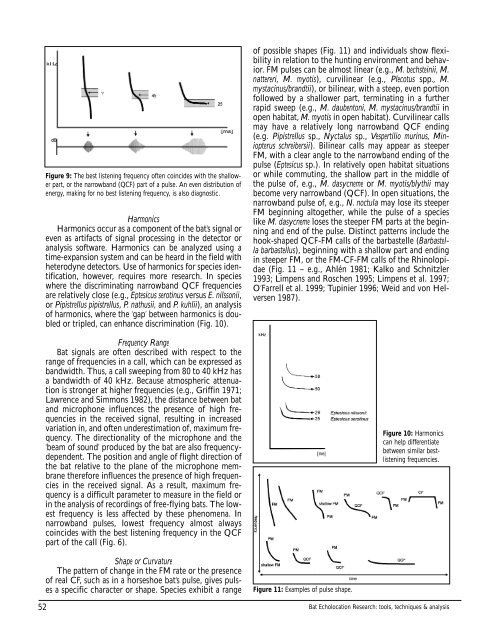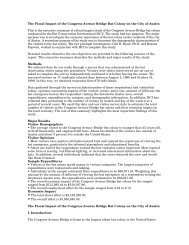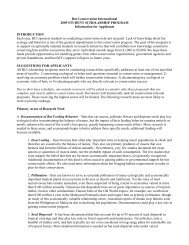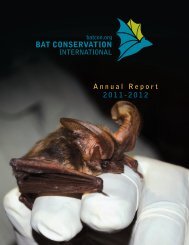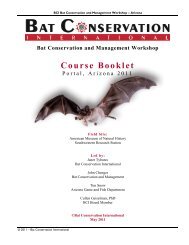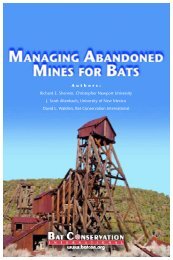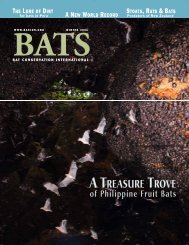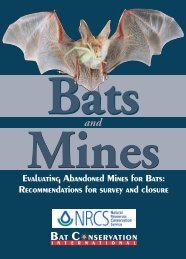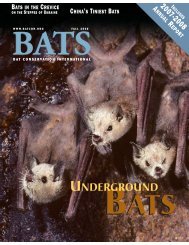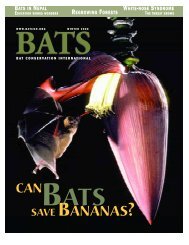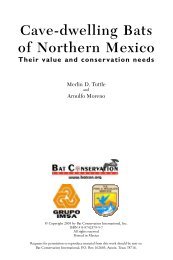Bat Echolocation Researc h - Bat Conservation International
Bat Echolocation Researc h - Bat Conservation International
Bat Echolocation Researc h - Bat Conservation International
You also want an ePaper? Increase the reach of your titles
YUMPU automatically turns print PDFs into web optimized ePapers that Google loves.
Figure 9: The best listening frequency often coincides with the shallower<br />
part, or the narrowband (QCF) part of a pulse. An even distribution of<br />
energy, making for no best listening frequency, is also diagnostic.<br />
Harmonics<br />
Harmonics occur as a component of the bat’s signal or<br />
even as artifacts of signal processing in the detector or<br />
analysis software. Harmonics can be analyzed using a<br />
time-expansion system and can be heard in the field with<br />
heterodyne detectors. Use of harmonics for species identification,<br />
however, requires more research. In species<br />
where the discriminating narrowband QCF frequencies<br />
are relatively close (e.g., Eptesicus serotinus versus E. nilssonii,<br />
or Pipistrellus pipistrellus, P. nathusii, and P. kuhlii), an analysis<br />
of harmonics, where the ‘gap’ between harmonics is doubled<br />
or tripled, can enhance discrimination (Fig. 10).<br />
Frequency Range<br />
<strong>Bat</strong> signals are often described with respect to the<br />
range of frequencies in a call, which can be expressed as<br />
bandwidth. Thus, a call sweeping from 80 to 40 kHz has<br />
a bandwidth of 40 kHz. Because atmospheric attenuation<br />
is stronger at higher frequencies (e.g., Griffin 1971;<br />
Lawrence and Simmons 1982), the distance between bat<br />
and microphone influences the presence of high frequencies<br />
in the received signal, resulting in increased<br />
variation in, and often underestimation of, maximum frequency.<br />
The directionality of the microphone and the<br />
‘beam of sound’ produced by the bat are also frequencydependent.<br />
The position and angle of flight direction of<br />
the bat relative to the plane of the microphone membrane<br />
therefore influences the presence of high frequencies<br />
in the received signal. As a result, maximum frequency<br />
is a difficult parameter to measure in the field or<br />
in the analysis of recordings of free-flying bats. The lowest<br />
frequency is less affected by these phenomena. In<br />
narrowband pulses, lowest frequency almost always<br />
coincides with the best listening frequency in the QCF<br />
part of the call (Fig. 6).<br />
Shape or Curvature<br />
The pattern of change in the FM rate or the presence<br />
of real CF, such as in a horseshoe bat’s pulse, gives pulses<br />
a specific character or shape. Species exhibit a range<br />
of possible shapes (Fig. 11) and individuals show flexibility<br />
in relation to the hunting environment and behavior.<br />
FM pulses can be almost linear (e.g., M. bechsteinii, M.<br />
nattereri, M. myotis), curvilinear (e.g., Plecotus spp., M.<br />
mystacinus/brandtii), or bilinear, with a steep, even portion<br />
followed by a shallower part, terminating in a further<br />
rapid sweep (e.g., M. daubentoni, M. mystacinus/brandtii in<br />
open habitat, M. myotis in open habitat). Curvilinear calls<br />
may have a relatively long narrowband QCF ending<br />
(e.g. Pipistrellus sp., Nyctalus sp., Vespertilio murinus, Miniopterus<br />
schreibersii). Bilinear calls may appear as steeper<br />
FM, with a clear angle to the narrowband ending of the<br />
pulse (Eptesicus sp.). In relatively open habitat situations<br />
or while commuting, the shallow part in the middle of<br />
the pulse of, e.g., M. dasycneme or M. myotis/blythii may<br />
become very narrowband (QCF). In open situations, the<br />
narrowband pulse of, e.g., N. noctula may lose its steeper<br />
FM beginning altogether, while the pulse of a species<br />
like M. dasycneme loses the steeper FM parts at the beginning<br />
and end of the pulse. Distinct patterns include the<br />
hook-shaped QCF-FM calls of the barbastelle (Barbastella<br />
barbastellus), beginning with a shallow part and ending<br />
in steeper FM, or the FM-CF-FM calls of the Rhinolopidae<br />
(Fig. 11 – e.g., Ahlén 1981; Kalko and Schnitzler<br />
1993; Limpens and Roschen 1995; Limpens et al. 1997;<br />
O’Farrell et al. 1999; Tupinier 1996; Weid and von Helversen<br />
1987).<br />
Figure 11: Examples of pulse shape.<br />
Figure 10: Harmonics<br />
can help differentiate<br />
between similar bestlistening<br />
frequencies.<br />
52 <strong>Bat</strong> <strong>Echolocation</strong> <strong>Researc</strong>h: tools, techniques & analysis


